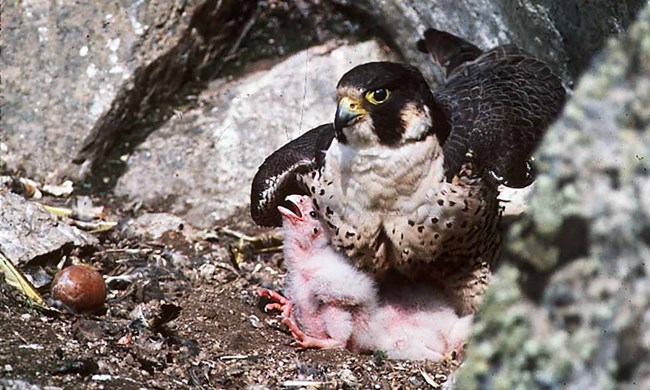Last updated: November 3, 2022
Article
High-latitude Peregrine Falcons

Intraspecific evolutionary relationships among peregrine falcons in western North American high latitudes
Abstract
Subspecies relationships within the peregrine falcon (Falco peregrinus) have been long debated because of the polytypic nature of melanin-based plumage characteristics used in subspecies designations and potential differentiation of local subpopulations due to philopatry. In North America, understanding the evolutionary relationships among subspecies may have been further complicated by the introduction of captive bred peregrines originating from non-native stock, as part of recovery efforts associated with mid 20th century population declines resulting from organochloride pollution. Alaska hosts all three nominal subspecies of North American peregrine falcons--F. p. tundrius, anatum, and pealei--for which distributions in Alaska are broadly associated with nesting locales within Arctic, boreal, and south coastal maritime habitats, respectively. Unlike elsewhere, populations of peregrine falcon in Alaska were not augmented by captive-bred birds during the late 20th century recovery efforts. Population genetic differentiation analyses of peregrine populations in Alaska, based on sequence data from the mitochondrial DNA control region and fragment data from microsatellite loci, failed to uncover genetic distinction between populations of peregrines occupying Arctic and boreal Alaskan locales. However, the maritime subspecies, pealei, was genetically differentiated from Arctic and boreal populations, and substructured into eastern and western populations. Levels of interpopulational gene flow between anatum and tundrius were generally higher than between pealei and either anatum or tundrius. Estimates based on both marker types revealed gene flow between augmented Canadian populations and unaugmented Alaskan populations. While we make no attempt at formal taxonomic revision, our data suggest that peregrine falcons occupying habitats in Alaska and the North Pacific coast of North America belong to two distinct regional groupings--a coastal grouping (pealei) and a boreal/Arctic grouping (currently anatum and tundrius)--each comprised of discrete populations that are variously intra-regionally connected.
Talbot, S. L., G. K. Sage, S. A. Sonsthagen, M. C. Gravley, T. Swem, J. C. Williams,J. L. Longmire, S. Ambrose, M. J. Flamme, S. B. Lewis, L. Phillips, C. Anderson, and C. M. White. 2017. Intraspecific evolutionary relationships among peregrine falcons in western North American high latitudes. Plos One 12(11):e0188185.
